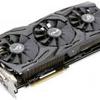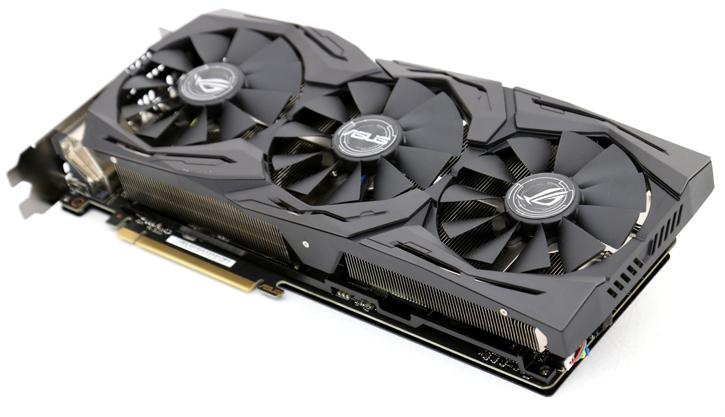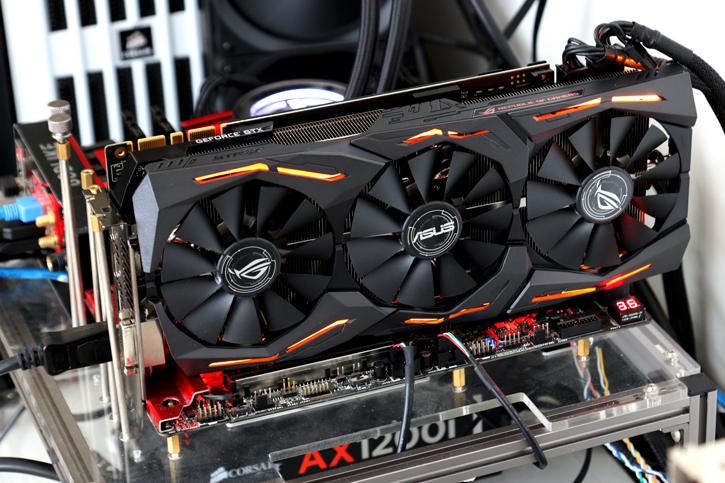Conclusion
Conclusion
The new STRIX is impressive. Let's face it, the default tweaked performance is roughly the same on all these cards, the extra memory does kick in. Where the card shines, however, is its amazing cooling performance, this card is running below 60 Degrees C under full load! Once you compare all the way back to a reference (Founders edition) GeForce GTX 1080 and apply a tweak and have this new 11 Gbps memory, you can gain up to 20% in performance. And that certainly is interesting. 11 Gbps or not? Admittedly, I like it. See, the performance on all models including tweaking results are all more or less the same due to the restrictions Nvidia applies. Hence differentiation is key for the board partners, the models that are better cooled or more silent.
You can argue for the thicker and longer size of the STRIX, all other flags, however, are tagged green including an excellent silent cooling solution, the looks are very nice (albeit this is subjective of course), it has a very nice LED implementation and then there are the extra features like the huge number of display connectors, that lovely nickel plating, the components usage selection and of course a nice four year warranty. The reality also remains that the differences in performance in-between all tweaked 1080 models is negligible. I mean, to date we have tested like eight tweaked SKUs from varying manufacturers and the differences in-between ALL cards are maybe 4 FPS, give or take 1 FPS. The problem with the highest-end SKUs is that they are more expensive, and that extra money just does not justify the little performance gain.
Right now the product sits in an overly inflated market at a very steep €719,- and that is not worth it. it's a 500 Euro/USD card really. But the entire VGA market is under stress due to everything that is called mining, however, just like gas, that should pass.
With the STRIX 11 Gbps, you are looking at that factory higher clock frequency and the LED logos with a massive cooler and a back-plate. Depending on the clock frequency modes you choose to use you may expect that dynamic boost clock hovering close to the 1.95 GHz marker with the default clocks and, yes, that is faster compared to the Founder edition. Your extra benefit obviously is that sweet 8 GB memory volume size now clocked at 11 Gbps with even higher tweakability to 12 Gbps.
Aesthetics
The STRIX is a very nice looking card. There's little more to say really. I like the dark design and, sure, the LEDs. All the extra RGB LED functionality like an RGB LED strip connector for me is not needed, hey - haters will hate, lovers will love it. Switch it on/off or to any color and animation you prefer, the choice is yours. Cool dibs is that back-plate, with openings in some areas (GPU/VRM) for venting. I'd like to see more vents though. As you can see, I remain skeptical about back-plates, they can potentially trap heat and thus warm up the PCB. But the flip-side is that they do look better and can protect your PCB and components from damage and, well, they can look nice so they have an aesthetic appeal as well. Consumer demand is always decisive, and you guys clearly like graphics cards with back-plates. Both the front IO plate and back-plate are dark matte black which certainly gives the card that premium feel.
Cooling & Noise Levels
The reference design (Founder edition) of the GTX 1080 is set at an offset threshold of 80 degrees C and easily hits 83 Degrees C under load/stress. As such, the reference card, once the GPU gets warmer, will clock down on voltage and base turbo clock to try to keep the card at that temperature threshold. That's throttling and is part of the design. This is not a problem for this ASUS STRIX card, as they threw heaps of cooling performance onto the GPU, memory and VRM area. History has proven that this concept works and is a really good one, so good that up-to a degree or 55~60 on the GPU this flagship card remains passive and thus inaudible. Once the fans kick in, you can expect to hover at the ~58 (!) Degrees C marker, with seriously demanding games. Please do note that you will need some ventilation inside your chassis to achieve that number as the card oozes out quite some heat at the top side of the VRM area. Overall though, the new cooling design shaves off over 20 Degrees C over reference.
Noise wise, we can’t complain about cooling whatsoever. Expect (silent) sound pressure values in the ~37 dBA range at max under load and warm circumstances. That's measured 75 CM away from the PC. This means you can barely hear the card while using it. Once overclocked you could add voltage and here we always do recommend a little more fan RPM, this does increase noise a tiny bit, but it's nothing dramatic by any standard. Overall this is a very silent and solid cooling solution. The card does produce a tiny bit of coil noise, nothing annoying but there is some that can be heard in high-fps situations. We doubt very much you could even notice it in a closed chassis.
Power Consumption
Any GP104 Pascal GPU and thus GP104 based graphics card is rated as having a 180 Watt TDP under full stress, our measurements show it to be a fair amount higher in the 225 Watt range during your average gaming session, likely due to the faster clocks and accompanied voltage usage. Anyhow, at this performance level you are looking at a card that consumes roughly 400~450 Watts for a stressed PC in total, that is okay. We think a 500~600 Watt PSU would be sufficient and, if you go with 2-way SLI, a 750 Watt power supply is recommended. It's definitely more than needed but remember - when purchasing a PSU, aim to double up in Wattage as your PSU is most efficient when it is under 50% load. Here, again, keep in mind we measure peak power consumption, the average power consumption is a good notch lower depending on GPU utilization. Also, if you plan to overclock the CPU/memory and/or GPU with added voltage, please do purchase a power supply with enough reserve. People often underestimate it, but if you tweak all three aforementioned variables, you can easily add 200 Watts to your peak power consumption budget as increasing voltages and clocks increase your power consumption.
Overall gaming performance
Do you really need a card as beefy as the GeForce GTX 1080 really is though? Well, that depends on a rather abstract external factor, your monitor(s) and more specifically the resolution you play your games at. If you game at a resolution of 1920x1080 (Full HD) then no, not really. However, more is better and with technologies like DSR (super-sampling) and Ultra HD the raw horsepower this card offers certainly isn't distasteful. Also, with surround gaming (three monitors) the GeForce GTX 1080 will just make a lot of sense, especially with the new simultaneous multi-projection feature build into the rendering pipeline, that probably is one of the most innovative features Nvidia has added that I have seen in a long time. From 1080p to Ultra HD the GeForce GTX 1080 hauls the proverbial toosh compared to whatever other single GPU based graphics card you can name in existence. Obviously, it is the fastest kid on the block. This much performance and graphics memory helps you in Ultra HD, hefty complex anti-aliasing modes, DSR and of course the latest gaming titles. I consider this to be among the first viable single GPU solutions that allow you to game properly in Ultra HD with some very nice eye candy enabled. However, I was kinda hoping to be closer to 60 FPS on average with the GTX 1080 in Ultra HD. But that will probably take the future Big Pascal (Ti / Titan). As always, drivers wise we can't complain at all, we did not stumble into any issues. And with a single GPU there's no micro-stuttering and no multi-GPU driver issues to fight off. Performance wise, really there's not one game that won't run seriously good at the very best image quality settings. Gaming you must do with a nice 30" monitor of course, at 2560x1440/1600 or Ultra HD. Now, we can discuss the advantages of an 8 GB framebuffer, but hey, you can draw your own conclusions there. At least you won't run out of graphics memory for the years to come, right? So in that respect, the card is rather future proof. SLI then, we have to mention this. Starting with Pascal the primary focus for Nvidia in terms of multi-GPU setups is that they will support 2-way SLI, but really that's it and all. One last remark on performance; you will have noticed that in some games this higher clocked product is a good 10% faster, yet in others just a few percent. That's Nvidia's limiters at work for you. All cards under very hefty load will be limited in a way narrower bracket, whereas games that leave enough breathing room can advance on that GPU and score better opposed to some other games.
Overclocking
Due to the many limiters and hardware protections, Nvidia has built in, all and any cards will hover roughly at or just over the 2 up to 2.1 GHz level on the Boost marker. Now, the one factor that can actually positively influence the boost speed a little is temperature as the GPU will then throttle less. And that did show as we could boost to 2050~2100 MHz, that is stable. On 3DMark Firestrike with this card tweaked (for example) it may hover at ~2075 MHz, while in Rise of the Tomb Raider (2016) you will be closer to 2.1 GHz. The reality is that Nvidia monitors and adapts to hardware specific loads, e.g. an application that is nearly viral like on the GPU will have the effect of the GPU protecting itself by lowering clocks and voltages. The opposite applies here as well, if a game does not try to fry that GPU, it'll clock a bit faster within the tweaked thresholds at your disposal. Tweaking is fun, but definitely more complicated anno 2016. The new memory can reach 12 Gbps effectively fairly easy. So if you can find a high enough stable tweak, definitely go for it if you are seeking that last bit of extra performance. Fact remains that the card is tweaked out of the box, and we'd advise sticking to these values.
Concluding
The new 11 Gbps model of the GeForce GTX 1080 STRIX offers a small step up in additional performance. It is not big enough to justify an upgrade if you are already fragging away in that 1070/1080 performance bracket. The GTX 1080 series is however lovely for up-to 2560x1440 gaming. Unfortunately, the entire graphics card market is now seeing the effect of cryptocurrency mining on GPU sales, and that is inflating the 1080 prices upwards as well. A 1080 should be priced at the 500 euro/USD marker. The lowest prices right now, however, are in the 600 euro range, and this particular STRIX OC model with 11 Gbps memory is a staggering €719,- I can recommend this product overall, but just not at that price as that is insane. Any GTX 1080 card is terrific in performance and any 1080 card will tweak to roughly the same levels, that is the stone cold message I have been relaying in all my reviews. In relative performance terms, this is one of the best 1080 cards we have tested to date, and your value is found in the extra features, the LED lit experience, a back-plate and a massive cooler with excellent cooling performance.
So yes, once again, for ASUS all lights are green for the STRIX OC, but the current inflated pricing at €719,- due to mining GPU demand raises a massive red flag.
Recommended Downloads
- Sign up to receive a notice when we publish a new article
- Or go back to Guru3D's front page




